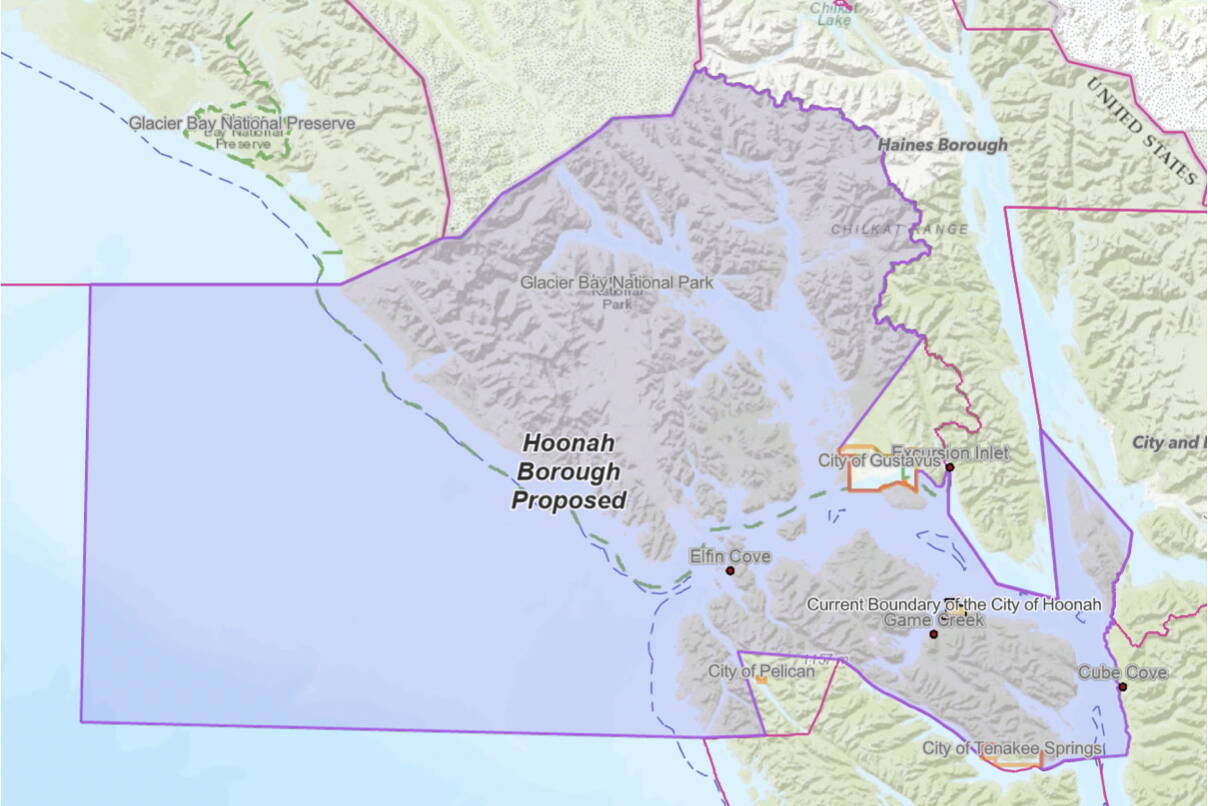The Southeast Alaska city of Hoonah has submitted a petition to the state Local Boundary Commission to create Alaska’s 20th organized borough, which would include the city and some lightly populated outlying communities.
The Xunaa Borough would include Hoonah, as well as Game Creek, Elfin Cove and Funter Bay. The potential borough’s name is a closer match to the Tlingit language word for the community.
“Voluntary incorporation is preferable to the potential alternative of either having a different borough government imposed upon residents by the state or leaving this entire region, except the existing City of Hoonah, unorganized,” city officials wrote in the petition.
In addition, city officials wrote, the proposed area includes “all of the Huna Tlingit’s historic territory” except for lower Chilkat Peninsula land that has already been incorporated in the Haines Borough. The area includes subsistence hunting and fishing grounds.
“The ability of the Huna Tlingit to influence future decisions regarding these lands is of critical importance to the Tribe,” according to the city government.
According to the 2020 census, there were 931 Hoonah residents, the vast majority of the 980 total residents of the proposed borough. It would be the state’s third-smallest borough in population, after Yakutat, which had 700 residents, and the Bristol Bay Borough, which had 865.
But the borough would incorporate more than 10,000 square miles of surface area, including more than 4,000 square miles of land – larger than the states of Rhode Island and Delaware combined – and more than 6,000 square miles of water, according to the petition. Its boundaries would stretch from the Yakutat and Haines to its north, Juneau and Chatham Strait to its east, Sitka to its south and the Pacific Ocean to its west.
Under the petition, Hoonah’s city government would be dissolved. The new borough would have a 1% seasonal sales tax, though residents of the area of the former city would continue to pay the 6.5% sales tax the city currently collects, leaving the few residents in outlying communities without the larger tax.
The Local Boundary Commission has the power under state law to decide whether to accept a petition after a several-month process. If the commission votes to accept the petition, then the residents of the proposed borough would have the final say by voting in an election on whether to form a borough. The petition proposes that voters decide on whether to add a tax on the same election ballot as the question on whether to form a borough.
Commission staff accepted the petition for review on Nov. 27. Dec. 1 marked the start of a 90-day period in which members of the public can comment on the petition. Under a schedule posted on the commission website, the commission staff must issue a report on the petition by Aug. 4, followed by a public meeting in Hoonah on Sept. 10 and a commission meeting to decide whether to accept the petition the following day. The formal written decision would be issued a month later, on Oct. 11.
If the commission votes to accept the petition, there would be an election in the proposed borough between 31 and 120 days after the written decision.
The commission has five members, four of whom were first appointed by Gov. Mike Dunleavy. The fifth commissioner, John Harrington of Ketchikan, was first appointed by Gov. Sean Parnell in 2006 and has been reappointed three times, most recently by Dunleavy.
Under state law, in order to incorporate, a borough population must be large and stable enough to support a borough government.
The Xunaa Borough boundaries would be smaller than those of a potential borough that the commission drew up in 1992 and included in a report on model borough boundaries that was revised in 1997, as well as in a 2003 report on areas that meet borough incorporation standards.
Those reports foresaw three other communities – Gustavus, Pelican and Tenakee Springs — along with Hoonah being combined into a future “Glacier Bay Borough.”
In a document Hoonah officials filed with the new petition, they said they contacted each of the other communities in 2022. According to the filing, Pelican leaders said joining the borough could affect Pelican’s status as a city and the possibility of it annexing adjacent land, while Gustavus leaders said its inclusion would decrease the possibility of the petition’s success. Tenakee officials didn’t respond to two requests, according to the document.
If the petition is successful, Xunaa would be the first new borough since Petersburg in 2013. It would include slightly more than 1% — 980 of 77,157 — of the Alaskans who did not live in an organized borough as of the 2020 census. Alaska is the only state in which some residents live in areas outside of counties or the equivalent of counties.
• Andrew Kitchenman has covered state government in Alaska since 2016, serving as the Capitol reporter for Alaska Public Media and KTOO before joining the Alaska Beacon. Before this, he covered state and local governments on the East Coast – primarily in New Jersey – for more than 15 years. This story originally appeared at alaskabeacon.com. Alaska Beacon, an affiliate of States Newsroom, is an independent, nonpartisan news organization focused on connecting Alaskans to their state government.

